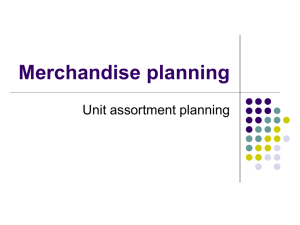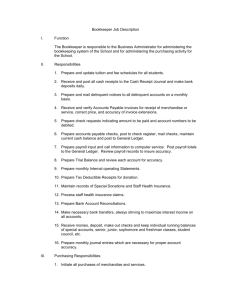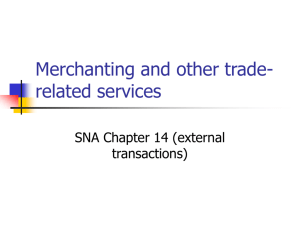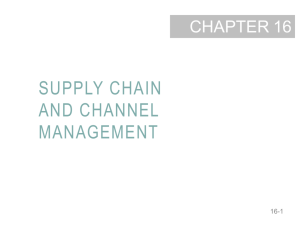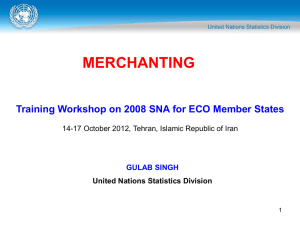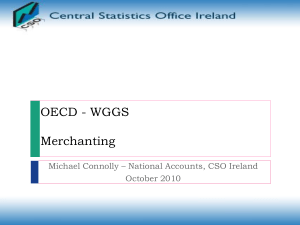Major Changes in the Goods account
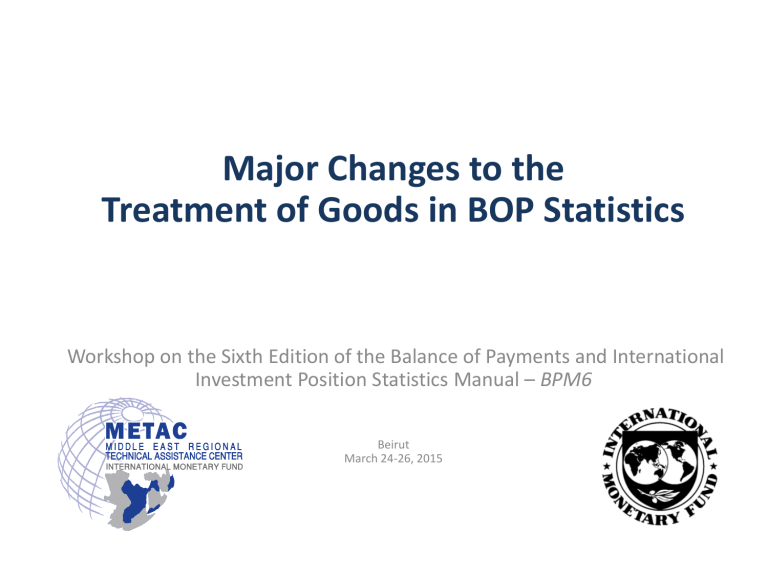
Major Changes to the
Treatment of Goods in BOP Statistics
Workshop on the Sixth Edition of the Balance of Payments and International
Investment Position Statistics Manual – BPM6
Beirut
March 24-26, 2015
Goods - Classification
The goods item is subdivided in BPM5:
• general merchandise
• goods for processing
• repair of goods
• goods procured in port by carriers
• nonmonetary gold in BPM6:
• general merchandise
• net exports of goods under merchanting
• nonmonetary gold
3
Changes from BPM5 – Goods Account
• Exceptions to the change of ownership principle are eliminated
(paragraphs 10.13, 10.22(b), 10.22(f), 10.24, 10.41–10.44; BPM5 paragraphs 119–120).
• Goods procured in ports by carriers are included under general merchandise rather than as a separate item under goods
(paragraph 10.17(d); BPM5 paragraphs 156 and 201).
• Goods for own use or to give away acquired by travelers that are in excess of customs thresholds are included in general merchandise, rather than travel (paragraphs 10.20 and 10.90; BPM5 paragraph
242).
• Migrants’ personal effects are not included in general merchandise or anywhere else in the international accounts paragraph 10.22(b);
BPM5 paragraph 353).
3
Changes from BPM5 – Goods Account
• The time of recording of transactions in high-value capital goods such as ships, heavy machinery, buildings, and other structures that take several months or years to complete is discussed (paragraph 10.28).
• Re-exports are defined and introduced as a supplementary item
(paragraphs 10.37–10.39).
• Merchanting of goods is classified under goods, with both gross and net values shown, with net amounts included in the goods aggregates.
Changes in inventories of goods under merchanting are no longer included under imports of general merchandise (paragraphs 10.41–10.49; BPM5 paragraph 262).
• A reconciliation table is introduced to show the relationship between international merchandise trade statistics and goods on a balance of payments basis (paragraphs 10.55–10.56, Table 10.2).
4
Changes from BPM5 – Goods Account
Now under Services:
• Manufacturing services on physical inputs owned by others are shown as a service in all cases. Previously, when the goods were supplied from the owner and returned to the owner, the value of the service was included in the value of goods. Previously, when the goods were not supplied by the owner or not returned to the owner, they were shown under miscellaneous business, professional, and technical services (paragraphs 10.62–10.71; BPM5
paragraphs 198–199).
• Maintenance and repair services n.i.e. are renamed in line with the
CPC and included under services, rather than goods, and the inclusion of maintenance of transport equipment is clarified
(paragraphs 10.72–10.73; BPM5 paragraphs 200 and 240).
5
Definition of General Merchandise
Definition of General Merchandise
General merchandise on a balance of payments basis covers goods that change economic ownership between residents and nonresidents and that are not included in the following specific categories:
•
goods under merchanting,
•
nonmonetary gold and
•
parts of travel, construction, and government services n.i.e. .
4
Coverage of General Merchandise
Exclusions
Coverage of General Merchandise
Exclusion of goods
Because a change of economic ownership is not entailed the following goods are excluded:
Transit trade.
Migrants’ personal effects
Goods consigned to embassies, military bases etc. from their home authorities, and vice versa.
Goods sent to an enterprise’s external operations where those operations were not substantial to constitute a branch.
Goods temporarily exported or imported without a change of ownership, e.g. goods for repair, as part of an operational lease, for storage, and animals or artifacts for participation in exhibitions or competitions.
9
Coverage of General Merchandise
Exclusions
Coverage of General Merchandise
Exclusion of goods (continued)
Because a change of economic ownership is not entailed the following goods are excluded:
Goods for assembly, packing, labeling, or processing by an entity that does not own the goods concerned.
Goods with no positive value.
Returned goods.
Samples of no commercial value.
Trade in goods between free trade zones and residents of the same economy
10
Coverage of General Merchandise
Exclusions
Goods excluded from general merchandise because they are included in other categories
Goods under merchanting
Nonmonetary gold, as bullion and other forms,
Goods that are included in travel
Goods locally acquired for construction undertaken by enterprises that are nonresident in the territory of the location of the work.
(construction debit)
Devices, such as disks, with stored computer software or data, that have been customized to order
Products such as packaged software (systems and applications), video and audio recordings delivered on physical media but are obtained with a fixed-period license to use
11
Coverage of General Merchandise
Exclusions
2. 4. Goods excluded from general merchandise because they are included in other categories (continued)
Licenses to reproduce or distribute (or both) audio and video that are conveyed by supply of the original recording
Customized blueprints and nonbulk newspapers and periodicals sent on the basis of direct subscription
12
Valuation of general merchandise
Valuation of general merchandise
In order to avoid variation in the valuation of merchandise exporters/importers in response to varying delivery terms underlying individual contracts, BPM6, in conformity with earlier editions of BPM and consistent with the SNA recommends a uniform point of valuation for general merchandise.
The principle for valuation of general merchandise is the market value of goods at the point of uniform valuation. The point of uniform valuation is at the customs frontier of the economy from which the goods are first exported, that is, free on board (FOB)
A clear distinction is made between (i) items regarded as goods and (ii) any additional distributive services that might be included in the final value of those goods is made in this manual.
18
Valuation of general merchandise
Valuation of general merchandise (continued)
FOB-type valuations include:
“Free on board” (FOB) at port on the frontier of the exporting country (for goods dispatched by sea or inland waterways);
“Free carrier” (FCA) at terminal on the frontier of the exporting country (for goods dispatched by means of transport to which FOB is not applicable) : and
“Delivered at frontier” of the exporting country (for goods dispatched by means of transport to which FOB and FCA are not applicable, e.g. when goods are exported by railroad or pipeline).
19
Re-exports
Re-exports
Re-exports are foreign goods (goods produced in other economies and previously imported) that are exported with no substantial transformation from the state in which they were previously imported
The price of re-exported good may differ from its price at the time it was originally imported due to such factors as transport costs, dealer’s margins, and holding gain/losses.
Re-imports are domestic goods imported in the same state as previously exported, without any substantial transformation occurring to the goods while they were outside the territory.
Where significant, re-exports and re-imports may be shown as a supplementary item.
20
Goods under Merchanting
Goods under merchanting
Merchanting is defined as the purchase of goods by a resident (of the compiling economy) from a nonresident combined with the subsequent resale of the goods to another nonresident without the goods being present in the compiling country.
The acquisition of goods by merchants is shown under goods as a negative export of the economy of the merchant.
The sale of the good is shown under merchanting as a
positive export of the economy of the merchant.
21
Goods under Merchanting
Goods under merchanting (continued)
•
The difference between sales over purchases of goods for merchanting is shown as the item “net exports” of goods under merchanting.
This item includes merchants’ margins, holding gains/losses, and changes in inventories of goods under merchanting.
As a result of losses or increases in inventories, net exports of goods under merchanting may be negative in some cases.
Merchanting entries are valued at transaction prices, not
FOB.
21
Example: Merchanting with manufacturing services that do not change the condition of the goods
A resident of Economy A acquires books from a resident of Economy B for 10.
The resident of Economy A has them sent to Economy C, without the books passing through Economy A, for a resident of Economy C to put in boxes, for a charge of 3 payable by the resident of Economy A.
The books are then sold by the resident of Economy A to a resident of
Economy D for 20.
Since the goods are in the same condition, the merchanting treatment applies.
21
Recording in BOP:
The goods and services account entries for Economy A would be:
Goods under merchanting (with Economy B) –10 CR.
(negative exports)
Goods under merchanting (with Economy D)
Net exports of goods under merchanting
20 CR.
10 CR.
Manufacturing services on physical inputs owned by others (with Economy
C) 3 DR.
The counterpart entries in Economies B and D would appear as exports and imports, respectively, under general merchandise, because goods under merchanting is only used for the economy of the merchant.
Nonmonetary Gold
Nonmonetary Gold
Non monetary gold covers all gold other than monetary gold.
Deposits to or withdrawals from allocated gold accounts in nonmonetary gold are treated as transactions in commodities, not deposits.
Unallocated gold accounts are treated as financial assets. Deposits by an entity other than monetary authorities or international organizations is shown as an exchange of non monetary gold for a financial asset; and a withdrawal is the reverse.
When both parties to a gold transaction are either monetary authorities that hold the gold as reserve assets or international financial organizations, gold sales are recorded as monetary gold in the financial account.
22
Issues in Compiling the Goods Accoun
t
• Most countries use IMTS as the main data source for compiling the goods account. However, IMTS normally based on customs forms are designed with a view to administrative requirements and may need adjusting for BOP purposes.
• It is important that the BOP compiler:
– Understand the international IMTS standard and its differences to the
BPM6
– Know the differences between national IMTS practice and the international IMTS standard
– Know where departures from BPM6 are material for his or her country
– Decide what adjustments should be made to the national IMTS to compile the BOP goods account — this would require having a suitable data source and method to undertake the adjustment.
Possible Deductions From IMTS
Using IMTS
Source and Method of Compilation
Goods for processing (without a legal change of ownership)
Goods for processing should not be included as goods in BOP if they do not entail a change of ownership. The BOP compiler may have to use ES or a supplementary inquiry to an ITRS to obtain the full range of information.
Migrants’ effects
Goods for repair and maintenance
Migrants’ effects should be excluded from the goods item in the BOP. It is possible that they may be separately identified in IMTS.
They are excluded from the goods item in the BOP and instead the cost of repairs and maintenance are included in the appropriate service item in the BOP. IMTS suggests their separate recording so that an ES may be considered to elicit the relevant information.
Possible Additions to the IMTS
Goods under merchanting
Using IMTS
Source and Method of Compilation
The relevant information may have to be obtained via an ES of the firms engaged in such transactions.
Goods lost or destroyed after leaving economic territory but before entering the economic territory of the importing country.
Import data of the country acquiring ownership of these goods would need to be adjusted. The information for BOP adjustments would, at least in significant cases, be obtained by approaching importers or insurance enterprises through ES.
Using ITRS
Merchandise trade statistics as provided in data source
Adjustments, as relevant (1) :
For example:
- CIF/FOB adjustment
- Goods for manufacturing without change of ownership
- Goods imported for projects by nonresident construction enterprises
- Goods lost or destroyed in transit
- Migrants’ personal effects
- Returned goods
- Goods for repair (without change of ownership)
- Goods sent to be held as inventories abroad (and not sold)
- High-value capital goods delivered, previously covered by stage payments
+ Fish catch, minerals from the seabed and salvage sold from resident-operated vessels (i) in foreign ports or(ii) on the high seas to foreign vessels
+ Goods entering/leaving customs warehouses
+ Goods entering/leaving territory illegally
+ Goods procured in ports by carriers
= General merchandise on a balance of payments' basis
Exports Imports

